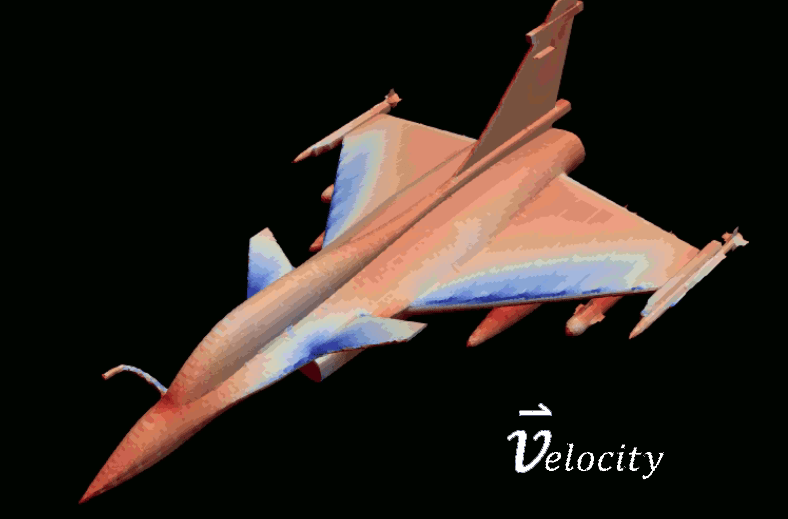What was first imagined in your mind when you hear the word CFD? Some people sometimes imagine the fluid flow around an object with a colorful graphic, that’s why CFD often thought of as Colorful fluid dynamics which is really cool and seems “advance” when you are about to make engineering or scientific presentation. This is not completely wrong, but they just understand CFD in its “beauty” part, the whole CFD is truly a complex algorithm and numerical method of fluid dynamics. But, don’t worry, in this article, we will discuss this topic in a simple but deep way.
So, what are the equations which govern the physics of fluid flow? why do they even need a numerical method to solve? why not just solve those equations analytically like, second-Newton law in solid body, for example? The answer simply because those equations can’t be solved analytically. Some simplifications may be used to solve the equations, but the general equations in its complete form can’t be solved smoothly, or if you can, maybe you deserve a price of $1.000.000 from Clay Mathematical Institute (read millennium price). This is because the equations are arranged using a high order non-linear partial differential equation.
From the above explanation, you should not feel intimidated with the following equations, because you are not alone. As we know from the general law of physics or universe, there are three quantities that always conserved (1) mass, (2) momentum and (3) Energy. These are the following explanation of each quantity (detailed mathematical explanation of these equations were discussed in the Fluid dynamics equations).
- THE CONSERVATION OF MASS
This law states the mass added into a controlled volume will always the same as the mass get out plus the mass increase in the volume. Or in fluid dynamics therm is the mass flow rate goes into the volume will always the same as the mass come out from the volume plus the rate of mass increase inside the volume. This is also known as continuity law. You can imagine this condition as filling a bathtub with tap water with the bottom flow outlet opens. If the water flowing into the bathtub from tap water is 1 kg/s, then the water flow through the bottom is 0,2 kg/s, the mass increase rate inside the bathtub will always be 0,8 kg/s.
The following is general partial differential equation form of the continuity equation in 3-dimensional space and time (transient):

2. THE CONSERVATION OF MOMENTUM
You can imagine this law as a newton second law, with the famous definition:

The definition of force itself basicaly is the rate of change of momentum,

The sum of momentum (mass * velocity) of the collided body will always be constant or conserved. This law also states the total forces exerted on the body is the sum of the forces from external as well as from the internal body itself (inertial force, gravity, pressure, viscosity etc.).
In the fluid dynamics equation, the forces are divided by volume and then can be rearranged as the following equation (in the x-direction):

The above equation is known as the famous Navier-Stokes equation. But, the Navier-Stokes equation sometimes refers to the continuity and energy equation as well.
3. THE CONSERVATION OF ENERGY
This energy conservation might be a little bit different from well known basic mechanical energy and potential energy equation, but the philosophy is the same. The conservation of energy in fluid mechanics tends to refer to the thermal energy aspect, the temperature relation to the flow (density, pressure etc). This is basically the first law of thermodynamics. This is the longest Navier-stokes form compared to the conservation of mass and momentum.

THE DISCRITEZATION PROCESS
At this point, we understand how complex are the governing equations of fluid mechanics, and in general, are impossible to solve analytically. One method to solve such a non-linear differential equation is using the numerical method, the method of convert partial differential (continuous) equation into the algebraic (discrete) equation.

If in the differential equation we use notation dx and dy, in the discrete form we change it into delta X and delta Y. This technique allows us to “approximate” the solution using the iterative algorithms. But, the long process of calculation and iteration process takes days or maybe years in some complex fluid flow by hand. it seems not a feasible solution? That’s why we need something which is faster than humans.
Yes right, computer!
Computer can’t solve partial differential equations directly, they can only solve the algebraic equations, but with tremendous speed compared to the human capability. Combining this numerical method and computational tools to solve fluid dynamics problems is called a Computational Fluid Dynamic.

MESHING
To apply the discrete equations into our fluid dynamic problems, we need to discretize our model or known as a fluid domain. This process also known as meshing or griding and the resulted domain called computational domain. The process of calculation and result interpretation occur in these domains.

PROCESSING
Processing or solving is the essence of CFD. The discrete forms of fluid dynamics equations above then solved using algorithms to approximate the solution numerically with the iterative process. The algorithms itself may vary case by case. we will discuss it later in the finite volume method in CFD.
THE COLORFUL PART: POST PROCESSING
After all solutions (velocity, pressure, density, turbulence, etc.) at each element in the computational domain has been calculated using iterative processes, then those quantities are distributed back in each element in the computational domain as a colored graphics:

In my view, all of those above processes will be paid off with the beauty of this post-processing result.
We also provide engineering consulting and project support for computational fluid dynamics. For more information, click here!
